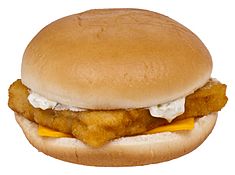Filet-O-Fish facts for kids
 |
|
| Nutritional value per 1 sandwich (141 g) | |
|---|---|
| Energy | 390 kcal (1,600 kJ) |
|
38 g (13%)
|
|
| Sugars | 5 g |
| Dietary fiber | 2 g (7%) |
|
19 g (29%)
|
|
| Saturated | 4 g (19%) |
| Trans | 0 g |
|
Protein
|
17 g
|
| Vitamins | Quantity
%DV†
|
| Vitamin A | 240 IU |
| Vitamin C |
0%
0 mg |
| Minerals | Quantity
%DV†
|
| Calcium |
6%
60 mg |
| Iron |
15%
2 mg |
| Sodium |
37%
560 mg |
| Other constituents | Quantity |
| Energy from fat | 170 kcal (710 kJ) |
| Cholesterol | 45 mg (15%) |
|
May vary outside US market. 360 kcal (1,500 kJ) in UK. Some restaurants publish nutritional information for the sandwich with the tartar sauce removed.
|
|
| †Percentages estimated using US recommendations for adults. Source: McDonald's |
|
The Filet-O-Fish is a popular fish sandwich sold by the fast food chain McDonald's. It was created in 1962 by Lou Groen, a McDonald's restaurant owner in Cincinnati, Ohio. He noticed that fewer people were buying hamburgers on Fridays. This was because many Christians, especially Roman Catholics, chose not to eat meat on Fridays. To help his sales, Lou Groen came up with the idea of a fish sandwich.
The Filet-O-Fish has always had the same basic parts. It includes a fried fish fillet, a soft steamed bun, creamy tartar sauce, and a slice of American cheese.
Contents
What's in a Filet-O-Fish?
The type of fish used for the Filet-O-Fish can be different depending on where you buy it.
- United States: The fish patty is made from Alaska pollock. It is battered and fried until crispy.
- Republic of Ireland: You might get either hoki or Alaska pollock.
- United Kingdom: It uses white Hoki or Pollock fish with crispy breadcrumbs.
- New Zealand: This country uses hoki fish instead of Alaska pollock.
McDonald's uses only half a slice of cheese in each Filet-O-Fish sandwich. They say this is to make sure the cheese doesn't overpower the taste of the fish.
The sandwich contains fish, milk (in the cheese), and egg yolks (in the sauce). It does not contain alcohol. In some Muslim-majority countries, like the UAE, it is certified as Halal, meaning it follows Islamic dietary laws. However, in the UK and US, it does not have this certification.
In France, a different version of the sandwich is sold. It's called the "McFish." This French version does not have cheese and uses ketchup instead of tartar sauce.
History of the Filet-O-Fish
The Filet-O-Fish was invented in 1962 by Lou Groen. He owned a McDonald's restaurant in Cincinnati, a city with many Catholic residents. Many Catholics chose not to eat meat on Fridays. This meant Lou's hamburger sales dropped a lot on those days. He needed a new idea to keep his business strong.
Ray Kroc, the owner of McDonald's, was thinking about adding new items to the menu. He made a deal with Lou Groen. On one Friday, they would sell two different non-meat sandwiches. Lou's Filet-O-Fish would compete against Ray Kroc's own idea, the "Hula Burger." The Hula Burger was grilled pineapple and cheese on a cold bun. The sandwich that sold the most would be added to the permanent menu. The Filet-O-Fish won easily! It was added to menus across the country by 1965.
Fish Changes Over Time
The type of fish used in the Filet-O-Fish has changed over the years. In 1981, a New Zealand fisheries company owner thought he could make a better-tasting fish fillet. He replaced the pollock with red cod. This led to an agreement to supply his local McDonald's with the new fillets. Later, hoki fish was used because it was easier to get and had boneless fillets. Hoki became widely used in the early 1990s when there were fewer pollock fish available globally.
In 1996, McDonald's removed the Filet-O-Fish from its menus in the United States. They replaced it with the Fish Filet Deluxe sandwich. However, many customers missed the Filet-O-Fish. They sent letters and petitions asking for it back. Because of this, McDonald's brought the Filet-O-Fish back in 1997. It even got the larger fish patty from the Fish Filet Deluxe. The Fish Filet Deluxe was eventually removed from all McDonald's menus by 2000.
Sustainable Fishing Efforts
McDonald's tries to use fish that comes from sustainable sources. This means fishing in a way that doesn't harm the environment or reduce fish populations too much. In 2007, McDonald's started using less New Zealand hoki and more Alaska pollock. This was because the hoki fish populations were declining.
The Marine Stewardship Council is an organization that certifies fisheries as sustainable. As of 2013, the Marine Stewardship Council stated that the pollock used by McDonald's comes from suppliers with sustainable fishing practices. McDonald's packaging and promotions now show this commitment to sustainable fishing.
In 2019, McDonald's sent a legal letter to a small Canadian restaurant. This restaurant was selling a fish sandwich called the 'Effing Filet O' Fish.' McDonald's said this name was too similar to their own 'Filet-O-Fish' trademark. The restaurant agreed to change the name of its sandwich.

